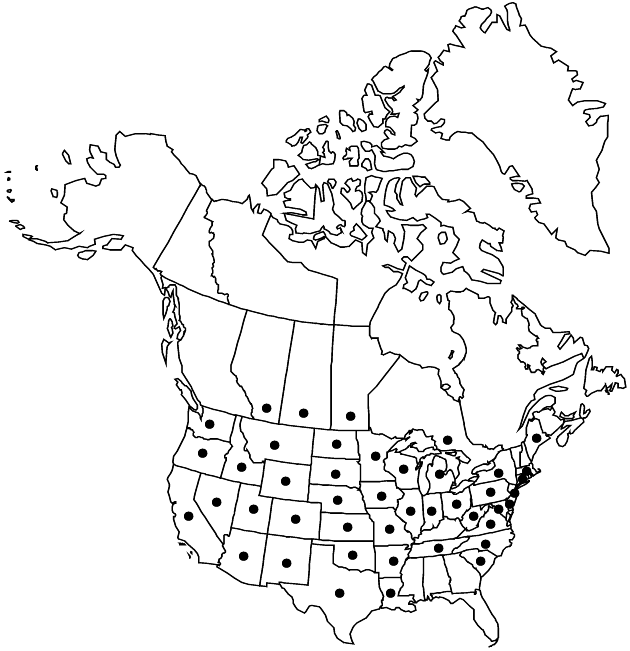Helianthus petiolaris
J. Acad. Nat. Sci. Philadelphia 2: 115. 1821.
Annuals, 40–200 cm. Stems erect, usually densely canescent, hispid, or strigillose, rarely ± hirsute or glabrate. Leaves mostly cauline; mostly alternate; petioles 2–4 cm; blades (often bluish green) lanceolate to deltate-ovate or ovate, 4–15 × 1–8 cm, bases subcordate or truncate to cuneate, margins entire or ± serrate, abaxial faces strigose, sparsely to densely, or not at all, glanddotted. Heads 1–5. Peduncles 4–15 (–40) cm. Involucres ± hemispheric, 10–24 mm diam. Phyllaries 14–25, lance-linear to lanceolate to lanceovate, 10–14 × 1–4 (–5) mm, (margins sometimes ciliate) apices short-attenuate, abaxial faces usually hispidulous, rarely sparsely hirsute to glabrate. Paleae 4.5–7.5 mm, 3-toothed, middle teeth ± ciliate or bearded, hairs whitish, 0.5–0.7 mm. Ray-florets 10–30; laminae 15–20 mm. Disc-florets 50–100+; corollas 4.5–6 mm, lobes usually reddish, rarely yellow; anthers reddish to purplish, appendages purplish (style-branches reddish). Cypselae 3–4.5 mm, ± villous; pappi of 2 aristate scales 1.5–3 mm plus 0–2 erose scales 0.3–0.5 mm. 2n = 34.
Distribution

Alta., Man., Ont., Sask., Ariz., Ark., Calif., Colo., Conn., D.C., Del., Idaho, Ill., Ind., Iowa, Kans., La., Maine, Mass., Mich., Minn., Mo., Mont., N.C., N.Dak., N.J., N.Mex., N.Y., Nebr., Nev., Ohio, Okla., Oreg., Pa., S.C., S.Dak., Tenn., Tex., Utah, Va., W.Va., Wash., Wis., Wyo.
Discussion
Subspecies 2 (2 in the flora).
Helianthus petiolaris is adventive beyond western North America.
A third subspecies has yet to be named at that rank in Helianthus petiolaris; it has been called H. petiolaris var. canescens A. Gray. It differs in having stems, leaves, and phyllaries densely canescent and abaxial faces of leaves densely gland-dotted. It is additionally characterized by peduncles usually ebracteate, phyllaries 1–2 mm wide, disc corolla throats gradually narrowed distal to slight, not densely hairy basal bulges, and 2n = 34. It flowers late spring through late summer and grows on sandy soils in open areas at (10–)1000–2300 m in Arizona, California, Nevada, New Mexico, and Texas and in Mexico. It was treated as H. niveus (Bentham) Brandegee subsp. canescens (A. Gray) Heiser by C. B. Heiser et al. (1969); molecular and morphologic data appear to favor a placement within H. petiolaris.
Selected References
None.
Key
| 1 | Stems usually hispidulous to strigillose; peduncles usually bractless; phyllaries 3–5 mm wide; disc corollas: throats abruptly narrowed distal to densely hairy basal bulbs | Helianthus petiolaris subsp. petiolaris |
| 1 | Stems usually ± hispid; peduncles usually each with leafy bract subtending head; phyllaries 2–3.5 mm wide; disc corollas: throats gradually narrowed distal to slight, not densely hairy, basal bulges | Helianthus petiolaris subsp. fallax |